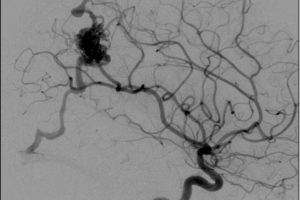What is an Angiogram

Angiograms are x-ray pictures of the inside of blood vessels. The doctor uses a catheter (a long, slim, flexible tube) to put dye in an artery and takes x-rays to help find any problems.
Why are angiograms used?
The angiogram allows your doctor to check the inside of a blood vessel to see if it is narrowed, leaking, enlarged, or blocked. Commonly used types of angiograms are:
Coronary angiogram. Pictures of the coronary arteries, which supply the heart muscle with blood, may show narrowing that makes a heart attack likely. Coronary angiograms can also show where and how much blockage exists after a heart attack.
Carotid angiogram. Carotid angiography is a procedure in which the health care provider examines your carotid arteries. These arteries travel up each side of the neck and supply blood to the brain. Angiograms of the carotid arteries can show if a stroke is likely because the arteries are narrowed or blocked. Angiograms can also show a tumor in the brain, or if there is an aneurysm, which is a weakened, bulging area in the artery wall.
Abdominal aortic angiogram. In an abdominal aortic angiogram, the health care provider looks at the large artery that leads from the heart to the rest of the body. Angiograms of the aorta can show if it is blocked or if there is an aneurysm (a weak, bulging area in the aorta).
Peripheral Arterial angiogram. Peripheral arterial angiograms can show narrowing of the arteries to the legs or arm.
Instead of an angiogram, you might have:
- a Sonogram/ Doppler (ultrasound exam)
- a CT Angio scan.
You should ask your doctor about these choices.
How do I prepare for this procedure?
Before the procedure, tell the doctor if you have had any kidney problems or reactions to iodine-containing substances, such as kidney contrast dye or seafood.
Follow the instructions provided by your doctor. Eat a light meal the night before the test. Do not eat or drink anything after midnight on the day of the procedure. Reach hospital in the morning fasting. Before the procedure, you would be taken to preparation area, where nurse would take necessary blood samples and your groin/arm would be shaved to remove hair.
What happens during the procedure?
Angiography procedure is done in Cardiac Catheterization lab. You would be fully awake during the procedure. You will feel very little discomfort during the procedure. Doctor injects a local anesthetic into your groin or hand area. A local anesthetic is a drug that should keep you from feeling pain during placement of the catheter.
The catheter is inserted and guided to the artery being checked. The doctor puts dye into the artery. Right after the injection of dye you may feel a warm or hot flush spreading over your body. This warm flush lasts only a few seconds. Sometimes the dye makes you feel like you have to urinate or move your bowels. This sensation also lasts only a few seconds and is normal.
X-rays are taken while the dye moves through your artery, Sometimes the x-rays are taken so fast that they form a movie of the progress of the dye. The x-rays show where the artery is blocked or narrowed and how much blockage, narrowing, or deformity there is. When the procedure is over, the catheter is removed. The whole procedure is recorded on a CD for review later.
A usual coronary angiogram takes only 10 to 15 min on the table. If it is done thru the radial ( Hand) route, and the result is normal,
What happens after the procedure?
After the angiogram you may be kept in an observation area for at least a few hours until any risk of bleeding is past. Avoid all strenuous activity for at least the rest of the day.
A provisional angiography report would be told to you and your relatives, immediately after the procedure. Your doctor would also discuss the possible treatment options.
Ask your doctor for specific instructions on how to care for yourself at home. Ask how and when you should expect to hear your test results. Make sure you know when you should come back for a checkup.
What are the benefits of this procedure?
Angiograms provide information that your health care provider cannot get any other way. It helps your health care provider determine the best treatment for you.
What are the risks associated with this procedure?
- In experienced hands coronary angiography is a very safe procedure. But as with any medical procedure, sometimes, minor complications can occur.
- A local anesthetic may not numb the area quite enough and you may feel some minor discomfort. Also, in rare cases, you may have an allergic reaction to the drug used in this type of anesthesia.
- If you have kidney problems, the dye might make them worse.
- Blood may form a clot around the catheter and block the artery.
- You may have bleeding where the catheter was inserted into your blood vessel. .
- Very Rarely you may have an allergic reaction to the dye, which may cause hives, trouble breathing, a drop in blood pressure, or swelling of the skin. But, this can be easily controlled by medicines
You should ask your doctor how these risks apply to you.
When should I call my cardiologist, after the angiography ?
- Your leg or foot becomes cool or cold.
- The puncture site begins to bleed, swell, or become more painful.
- You have slurred speech, balance problems, or trouble using your arm or leg.
You develop a rash.